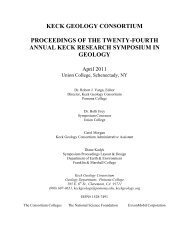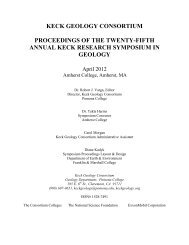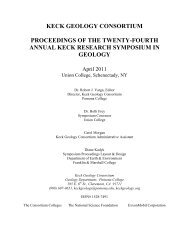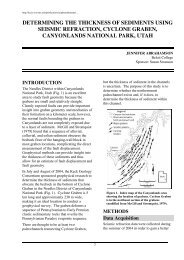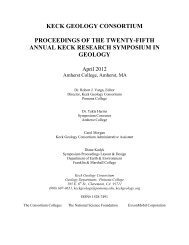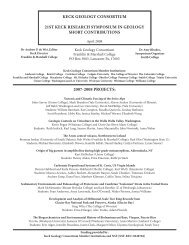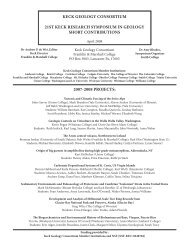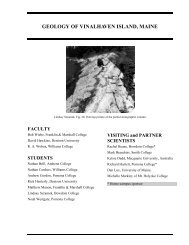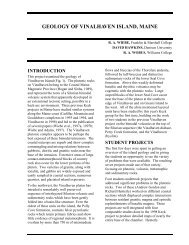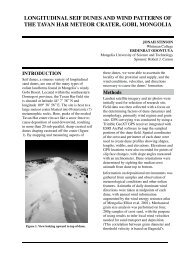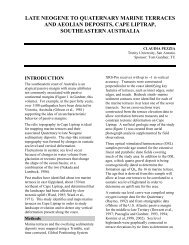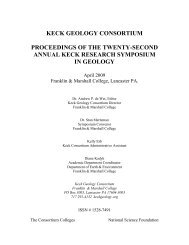mafic microgranular enclaves in a coarse grained granite ...
mafic microgranular enclaves in a coarse grained granite ...
mafic microgranular enclaves in a coarse grained granite ...
Create successful ePaper yourself
Turn your PDF publications into a flip-book with our unique Google optimized e-Paper software.
Guenthner, W. 2007. 20th Annual Keck Symposium; http://keck.wooster.edu/publications<br />
MAFIC MICROGRANULAR ENCLAVES IN A COARSE<br />
GRAINED GRANITE, VINALHAVEN ISLAND, MAINE:<br />
EVIDENCE FOR SILICIC MAGMA CHAMBER EVOLUTION<br />
WILLIAM GUENTHNER<br />
Carleton College<br />
Research Advisor: Bereket Haileab<br />
INTRODUCTION<br />
The dom<strong>in</strong>ant lithologic unit <strong>in</strong> the V<strong>in</strong>alhaven<br />
Intrusion, a <strong>coarse</strong>-gra<strong>in</strong>ed biotite-hornblende<br />
<strong>granite</strong>, has been shown by qualitative field<br />
observations to be texturally heterogenous with<br />
occurrences of magmatic <strong>enclaves</strong> <strong>in</strong> numerous<br />
locations. In order to better understand the<br />
processes contribut<strong>in</strong>g to enclave formation<br />
and <strong>in</strong> turn provide an important constra<strong>in</strong>t<br />
on the processes that operated with<strong>in</strong> the<br />
magmatic chambers of the complex, this<br />
study characterizes the spatial distribution<br />
and geochemical composition of magmatic<br />
<strong>enclaves</strong> <strong>in</strong> this unit us<strong>in</strong>g detailed textural<br />
and stratigraphic <strong>in</strong>formation along with<br />
enclave and <strong>granite</strong> whole rock geochemistry.<br />
This stratigraphic <strong>in</strong>formation <strong>in</strong>cludes field<br />
observations taken at various stratigraphic<br />
levels with<strong>in</strong> the <strong>coarse</strong>-gra<strong>in</strong>ed <strong>granite</strong>, pay<strong>in</strong>g<br />
attention to textural differences between levels,<br />
with particular <strong>in</strong>terest <strong>in</strong> enclave nature and<br />
abundance. By comb<strong>in</strong><strong>in</strong>g enclave abundance<br />
data with whole rock geochemistry I am able<br />
to construct a two stage enclave petrogenesis<br />
model <strong>in</strong>volv<strong>in</strong>g vary<strong>in</strong>g degrees of enclave<br />
hybridization and dispersal from source regions.<br />
METHODS<br />
The <strong>coarse</strong> gra<strong>in</strong>ed <strong>granite</strong> (CGG) was<br />
exam<strong>in</strong>ed <strong>in</strong> f<strong>in</strong>e detail at 51 stations spread<br />
across several dist<strong>in</strong>ct areas of the <strong>granite</strong> body:<br />
two areas where <strong>coarse</strong>-gra<strong>in</strong>ed <strong>granite</strong> is found<br />
with<strong>in</strong> the gabbro-diorite unit near the base of<br />
the <strong>in</strong>trusion, an area that represents a transect<br />
which proceeds from the f<strong>in</strong>al contact between<br />
the gabbro-diorite and <strong>granite</strong> units towards the<br />
<strong>in</strong>terior of the <strong>granite</strong> body and an area near<br />
the roof of the <strong>in</strong>trusion <strong>in</strong> which the <strong>granite</strong><br />
contacts the volcanic country rock. At each<br />
locality, the relative abundance, composition,<br />
and size of <strong>enclaves</strong> with<strong>in</strong> the <strong>coarse</strong>-gra<strong>in</strong>ed<br />
<strong>granite</strong> were characterized. Local abundance<br />
was assessed us<strong>in</strong>g measur<strong>in</strong>g tape to cordon<br />
off a well-exposed outcrop surface and then<br />
systematically count<strong>in</strong>g the number of <strong>enclaves</strong><br />
with<strong>in</strong> each box while pay<strong>in</strong>g attention to<br />
enclave size and shape. Box sizes ranged from<br />
3.90 square meters up to 71.37 square meters<br />
with a total observed area of 1461.80 square<br />
meters.<br />
A total of 26 rock samples were collected from<br />
all localities. Granitic samples consisted of<br />
one or more CGG samples from each area<br />
with additional samples represent<strong>in</strong>g either<br />
felsic dikes or granitic rocks of <strong>in</strong>terest<strong>in</strong>g<br />
textures (porphyry or CGG with a significant<br />
matrix component). Enclaves represented<br />
the other sampled rock type, however, due<br />
to the difficulty of extraction, <strong>enclaves</strong> were<br />
not sampled as systematically as the <strong>granite</strong>s.<br />
X-ray fluorescence spectrometry was used<br />
to determ<strong>in</strong>e major and m<strong>in</strong>or element<br />
compositions for 25 samples. It should be noted<br />
that this work was conducted with the assistance<br />
of Alice Colman (this volume). I shared the<br />
same or similar field areas with Alice and<br />
several of the samples and enclave abundance<br />
112
Guenthner, W. 2007. 20th Annual Keck Symposium; http://keck.wooster.edu/publications<br />
counts used <strong>in</strong> this report come from her field<br />
areas.<br />
RESULTS<br />
Enclave Counts<br />
For the purposes of convey<strong>in</strong>g and discuss<strong>in</strong>g<br />
results, field sites are broken up <strong>in</strong>to a gabbrodiorite<br />
area, west coast transect area, and an area<br />
near the roof of the <strong>in</strong>trusion. Mean average<br />
enclave counts for each field site are plotted on a<br />
map of V<strong>in</strong>alhaven (Fig.1). Most noticeable on<br />
the map is the appearance of two areas, Smith<br />
Po<strong>in</strong>t and The Grange, where relatively high<br />
enclave abundances occur, with 3.51 and 2.17<br />
<strong>enclaves</strong> per square meter respectively.<br />
Outcrops of course gra<strong>in</strong>ed <strong>granite</strong> that lie<br />
with<strong>in</strong> the gabbro-diorite unit show a relatively<br />
wide variance <strong>in</strong> enclave abundance. Arey Neck<br />
yields the lowest number of reported <strong>enclaves</strong><br />
per square meter with 0.20 while Coomb’s Neck<br />
has an enclave density that is six times that<br />
number. Round Neck strikes a balance between<br />
these two with 0.94 <strong>enclaves</strong> per square meter.<br />
Enclave abundance from the base of the CGG<br />
and gabbro-diorite contact up to the roof<br />
represented by the Dog Po<strong>in</strong>t to Leadbetter<br />
Narrows transect shows a decrease <strong>in</strong> enclave<br />
abundance as we proceed upstrike with<br />
abundances of 1.26 <strong>enclaves</strong> per square meter at<br />
44 ° 5’ 00”<br />
Penobscot Bay<br />
= 1.00 Enclave per Square Meter<br />
Coomb’s Neck<br />
1.27<br />
Leadbetter Narrows<br />
.61<br />
0 1km<br />
N<br />
Barton Island<br />
.80<br />
Dyer Island<br />
.68<br />
The Grange<br />
2.17<br />
44 ° 2’ 30”<br />
Dog Po<strong>in</strong>t<br />
1.26<br />
Smith Po<strong>in</strong>t<br />
3.51<br />
Round Neck<br />
.94<br />
68 ° 52’ 30” 68 ° 47’ 30”<br />
Ayer Neck<br />
.20<br />
Atlantic Ocean<br />
Figure 1. Mean average enclave abundance for locations on V<strong>in</strong>alhaven Island. Numbers under place<br />
names are reported as <strong>enclaves</strong> per square meter. Transect area marked by Dog Po<strong>in</strong>t north to Leadbetter<br />
Narrows shows a overall decrease <strong>in</strong> enclave abundance. Large pulses are present at Smith Po<strong>in</strong>t and The<br />
Grange. Round Neck, Ayer Neck, and Coomb’s Neck are all areas of course gra<strong>in</strong>ed <strong>granite</strong> ly<strong>in</strong>g with<strong>in</strong><br />
the gabbro-diorite unit and they demonstrate a wide variance <strong>in</strong> enclave abundance numbers.<br />
113
Guenthner, W. 2007. 20th Annual Keck Symposium; http://keck.wooster.edu/publications<br />
Dog Po<strong>in</strong>t dropp<strong>in</strong>g to less than half that value<br />
at Leadbetter Narrows. The roof of the <strong>in</strong>trusion<br />
represented by the outcrops at Leadbetter<br />
Narrows yields a relatively sparse abundance of<br />
only .61 <strong>enclaves</strong> per square meter.<br />
Whole-Rock Geochemistry<br />
Discrim<strong>in</strong>ation diagrams (Fig. 2) show that<br />
three of the four transect <strong>enclaves</strong> (WRG6-18A,<br />
WRG6-20A, WRG6-31A) group together <strong>in</strong>to<br />
the metalumionous and granodiorite regions<br />
with one sample (WRG6-31A) border<strong>in</strong>g<br />
between granodiorite, trondhjemite, and tonalite.<br />
A.<br />
3<br />
Metalum<strong>in</strong>ous<br />
Peralum<strong>in</strong>ous<br />
2<br />
Al/(Na+K)<br />
1<br />
Peralkal<strong>in</strong>e<br />
0<br />
1.0 1.5 2.0<br />
Al/(Ca+Na+K)<br />
B.<br />
Ab<br />
Tonalite<br />
Trondhjemite<br />
An<br />
Granite<br />
Dike<br />
Porphyry<br />
Transect Enclave<br />
Roof Enclave<br />
Mafic Sheet Enclave<br />
Granodiorite<br />
Granite<br />
Or<br />
Figure 2. Discrim<strong>in</strong>ation diagrams<br />
for granitic bodies and <strong>enclaves</strong><br />
from various locations. A) Al/(Na<br />
+ K) versus Al/(Ca + Na + K)<br />
show<strong>in</strong>g group<strong>in</strong>gs of various<br />
samples. Note that <strong>granite</strong>s plot <strong>in</strong><br />
peralum<strong>in</strong>ous space while transect<br />
<strong>enclaves</strong>, circled on diagram, are<br />
classified as metalum<strong>in</strong>ous. Also<br />
of <strong>in</strong>terest is the wide chemical<br />
discrepancy between <strong>mafic</strong> sheet<br />
enclave samples highlighted by the<br />
dashed l<strong>in</strong>e. Discrim<strong>in</strong>ation fields<br />
of Maniar and Piccoli (1989)<br />
superimposed. B) Normative<br />
albite, anorthite, and orthoclase<br />
plot of granitic and enclave<br />
samples. All granitic bodies plot<br />
solidly <strong>in</strong> the <strong>granite</strong> field while<br />
transect <strong>enclaves</strong>, circled on<br />
diagram, fall <strong>in</strong>to granodiorite<br />
space with two samples border<strong>in</strong>g<br />
on tonalite. Aga<strong>in</strong>, a wide chemical<br />
variance between the three<br />
<strong>mafic</strong> sheet <strong>enclaves</strong> is observed as<br />
marked by the dashed l<strong>in</strong>e. Weight<br />
normalized accord<strong>in</strong>g to Irv<strong>in</strong>e and<br />
Baragar (1971) with petrographic<br />
fields of Barker (1979) superimposed.<br />
114
Guenthner, W. 2007. 20th Annual Keck Symposium; http://keck.wooster.edu/publications<br />
The other transect enclave sample (WRG6-38A)<br />
plots with the granitic samples. Likewise, the<br />
s<strong>in</strong>gle roof enclave sample (WRG6-50A) can<br />
be classified as a peralum<strong>in</strong>ous <strong>granite</strong>. WRG6-<br />
48D plots high <strong>in</strong> both metalumionous and<br />
granodiorite space while the other <strong>mafic</strong> sheet<br />
enclave samples (WRG6-48B, WRG6-48C) plot<br />
together as peralum<strong>in</strong>ous <strong>granite</strong>s with a wide<br />
variance from WRG6-48D.<br />
Harker diagrams of all samples for n<strong>in</strong>e major<br />
elements display similar results (Fig. 3).<br />
Enclave samples WRG6-38A (transect) and<br />
WRG6-50A (roof) plot with the granitic bodies.<br />
The rema<strong>in</strong><strong>in</strong>g transect enclave samples group<br />
together on most plots and show enrichments <strong>in</strong><br />
the elements Fe, Mg, Ti, Mn, Na, and Ca and a<br />
depletion <strong>in</strong> K with respect to the <strong>granite</strong>s.<br />
A wide variance <strong>in</strong> <strong>mafic</strong> sheet <strong>enclaves</strong> is<br />
observed aga<strong>in</strong> <strong>in</strong> the Harker diagrams. WRG6-<br />
48B and WRG-48C are grouped together and<br />
separated from WRG6-48D. All three <strong>mafic</strong><br />
sheet <strong>enclaves</strong> are enriched <strong>in</strong> Fe, Mg, and Ti<br />
and depleted <strong>in</strong> Na with respect to the <strong>granite</strong>s.<br />
WRG6-48D is enriched <strong>in</strong> Mn, P, Ca and<br />
depleted <strong>in</strong> K with respect to the <strong>granite</strong>s while<br />
the other two <strong>mafic</strong> sheet samples show trends<br />
similar to the <strong>granite</strong>s <strong>in</strong> Mn, P, and Ca with<br />
enrichment <strong>in</strong> K.<br />
4<br />
3.5<br />
3<br />
Granite<br />
MgO (wt %)<br />
2.5 Transect<br />
2<br />
Enclave<br />
Mafic Sheet<br />
1.5<br />
Enclave<br />
Roof Enclave<br />
1<br />
Porphyry<br />
0.5<br />
0<br />
Dike<br />
50 55 60 65 70 75 80<br />
3.5<br />
3<br />
2.5<br />
2<br />
1.5<br />
1<br />
0.5<br />
TiO2 (wt %)<br />
0<br />
50 55 60 65 70 75 80<br />
5<br />
Na2O (wt %)<br />
4.5<br />
4<br />
3.5<br />
3<br />
2.5<br />
2<br />
1.5<br />
1<br />
0.5<br />
0<br />
50 55 60 65 70 75 80<br />
SiO2<br />
16<br />
Fe2O3 (wt %)<br />
14<br />
12<br />
10<br />
8<br />
6<br />
4<br />
2<br />
0<br />
50 55 60 65 70 75 80<br />
0.25<br />
MnO (wt %)<br />
0.2<br />
0.15<br />
0.1<br />
0.05<br />
0<br />
50 55 60 65 70 75 80<br />
6<br />
CaO (wt %)<br />
5<br />
4<br />
3<br />
2<br />
1<br />
0<br />
50 55 60 65 70 75 80<br />
SiO2<br />
16<br />
14<br />
12<br />
10<br />
Al2O3 (wt %)<br />
8<br />
6<br />
4<br />
2<br />
0<br />
50 55 60 65 70 75 80<br />
1.4<br />
P2O5 (wt %)<br />
1.2<br />
1<br />
0.8<br />
0.6<br />
0.4<br />
0.2<br />
0<br />
50 55 60 65 70 75 80<br />
7<br />
K2O (wt %)<br />
6<br />
5<br />
4<br />
3<br />
2<br />
1<br />
0<br />
50 55 60 65 70 75 80<br />
SiO2<br />
Figure 3. Harker diagrams for n<strong>in</strong>e major elements. Granites, dikes and porphyry group together while enclave samples show a wide variance <strong>in</strong> percentages<br />
for each element. Three out of the four transect <strong>enclaves</strong> group closely together for almost all major elements as <strong>in</strong>dicated by the circles. Dashed l<strong>in</strong>es demonstrate<br />
the wide variance between WRG6-48D and the other <strong>mafic</strong> sheet <strong>enclaves</strong> for most elments.<br />
115
Guenthner, W. 2007. 20th Annual Keck Symposium; http://keck.wooster.edu/publications<br />
DISCUSSION<br />
I argue that a simplified petrogenesis model<br />
is possible when chemical data is exam<strong>in</strong>ed<br />
alongside enclave abundance counts. The<br />
follow<strong>in</strong>g model is summarized <strong>in</strong> Figure 4.<br />
If we accept the process of magma m<strong>in</strong>gl<strong>in</strong>g<br />
as the model that best expla<strong>in</strong>s the presence<br />
of <strong>enclaves</strong> <strong>in</strong> the V<strong>in</strong>alhaven Intrusion (a<br />
worthy claim given the chemical plots and<br />
observed field relationships), then based upon<br />
the discrim<strong>in</strong>ation (Fig. 2) and Harker Diagrams<br />
(Fig.3), we can assert that the transect <strong>enclaves</strong><br />
saw relatively moderate to high hybridization<br />
and liquid <strong>in</strong>teraction, the s<strong>in</strong>gle roof enclave<br />
saw high hybridization and liquid <strong>in</strong>teraction<br />
and the <strong>mafic</strong> sheet <strong>enclaves</strong> saw highly variable<br />
relative hybridization and liquid <strong>in</strong>teraction<br />
rang<strong>in</strong>g from low to high.<br />
mostly or all liquid. This liquid nature allowed<br />
for ample hybridization and magma flow. S<strong>in</strong>ce<br />
enclave counts near the base of the CGG are<br />
relatively homogenous (except for the swarms at<br />
Smith Po<strong>in</strong>t), it is likely that convection, driven<br />
by thermal buoyancy and reduced viscosity and<br />
density contrasts between enclave and <strong>granite</strong><br />
tied to hybridization (Vernon, 1991; Vasek and<br />
Kolker, 1999), distributed <strong>enclaves</strong> near the<br />
base of the chamber. Whole-scale turbulent<br />
convection was most likely not occurr<strong>in</strong>g dur<strong>in</strong>g<br />
this stage of the <strong>in</strong>trusions history as enclave<br />
abundance is not homogenous throughout the<br />
CGG unit.<br />
Source material for these <strong>enclaves</strong> undoubtedly<br />
came from the <strong>mafic</strong> <strong>in</strong>trusions present on<br />
V<strong>in</strong>alhaven Island with dike fragmentation<br />
A. B.<br />
~4 km<br />
~4 km<br />
?<br />
?<br />
?<br />
?<br />
Figure 4. Conceptual model for two stage process of enclave peterogenesis. A. Early stage <strong>in</strong>volves a mostly liquid <strong>granite</strong> <strong>in</strong>teract<strong>in</strong>g<br />
with <strong>mafic</strong> <strong>in</strong>jections to cause dike fragmentation and enclave hybridization. Convective dispersal creates a homogenous basal<br />
layer of <strong>enclaves</strong> while swarms accumulate near dikes. The process of upward dispersal is unknown. B. Second stage <strong>in</strong>volves a<br />
mostly solid <strong>granite</strong> <strong>in</strong> which <strong>mafic</strong> <strong>in</strong>jections pond at the base of the chamber result<strong>in</strong>g <strong>in</strong> m<strong>in</strong>imal enclave creation and thermal<br />
rejuvenation of the <strong>granite</strong> lead<strong>in</strong>g to porphyry formation. Note the scal<strong>in</strong>g and that the chamber has grown <strong>in</strong> size s<strong>in</strong>ce <strong>in</strong>itial stages<br />
of enclave formation.<br />
Comb<strong>in</strong><strong>in</strong>g these assertions about degree of<br />
hybridization with enclave abundance data, we<br />
can imag<strong>in</strong>e enclave formation <strong>in</strong> the ma<strong>in</strong> CGG<br />
unit as occurr<strong>in</strong>g at a time when the <strong>granite</strong> was<br />
be<strong>in</strong>g a likely cause for hybridized <strong>enclaves</strong><br />
(Fernandez and Barbar<strong>in</strong>, 1991; Tobisch et<br />
al., 1997). Enclave swarms at locations such<br />
as Smith Po<strong>in</strong>t and The Grange are probably<br />
the local result of these dike fragmentations,<br />
116
Guenthner, W. 2007. 20th Annual Keck Symposium; http://keck.wooster.edu/publications<br />
although no such dikes were observed at either<br />
location. It is important to note that many of the<br />
<strong>mafic</strong> <strong>in</strong>trusions on V<strong>in</strong>alhaven Island are not<br />
fragmented or dispersed and this discrepancy<br />
speaks to a petrologic history more diverse than<br />
the one just put forth.<br />
Presently observed <strong>mafic</strong> <strong>in</strong>jections ponded<br />
on the base of the chamber giv<strong>in</strong>g rise to the<br />
vary<strong>in</strong>g textural structures observed <strong>in</strong> the<br />
gabbro-diorite unit (Wiebe et al., 2001). This<br />
pond<strong>in</strong>g occurred at a time after the <strong>in</strong>itial<br />
enclave formation discussed above and when<br />
the <strong>granite</strong> was more crystallized and therefore<br />
did not permit significant hybridization or<br />
convection of <strong>enclaves</strong>. It is likely that the<br />
<strong>mafic</strong> sheet <strong>enclaves</strong> owe much of their<br />
petrologic history to these events. Primitive<br />
<strong>enclaves</strong> <strong>in</strong> the <strong>mafic</strong> sheets (i.e. WRG6-48D)<br />
formed locally and experienced little liquid<br />
<strong>in</strong>teraction and hybridization as evidenced<br />
by relatively basic m<strong>in</strong>eral and chemical<br />
compositions. The more evolved <strong>enclaves</strong> are<br />
remnants of earlier enclave formation which<br />
experienced subsequent and repeated thermal<br />
rejuvenation. This argument is strengthened by<br />
the fact that WRG6-48B and WRG6-48C were<br />
emplaced with<strong>in</strong> f<strong>in</strong>e gra<strong>in</strong>ed, apilitic, <strong>granite</strong><br />
bodies ly<strong>in</strong>g <strong>in</strong> close proximity to porphyritic<br />
granitoids. This complexity <strong>in</strong> enclave<br />
formation history and lack of homogenous<br />
dispersal (a process facilitated by convection)<br />
expla<strong>in</strong>s the vary<strong>in</strong>g enclave numbers with<strong>in</strong> the<br />
<strong>mafic</strong> sheets.<br />
Tobisch, O. T., McNulty, B. A., and Vernon, R.<br />
H., 1997, Microgranitoid enclave swarms<br />
<strong>in</strong> granitic plutons, central Sierra Nevada,<br />
California: Lithos, v. 40, no. 2-4, p. 321-<br />
339.<br />
Vasek, R. W., and Kolker, A., 1999, Virg<strong>in</strong>ia<br />
Dale <strong>in</strong>trusion, Colorado and Wyom<strong>in</strong>g:<br />
Magma-mix<strong>in</strong>g and hybridization <strong>in</strong> a<br />
Proterozoic composite <strong>in</strong>trusion Journal of<br />
Rocky Mounta<strong>in</strong> Geology, v. 34, no. 2, p.<br />
195-222.<br />
Vernon, R. H., 1991, Interpretation of<br />
microstructures <strong>in</strong> microgranitoid<br />
<strong>enclaves</strong>, <strong>in</strong> Didier, J., and Barbar<strong>in</strong>, B.,<br />
eds., Enclaves and Granite Petrology:<br />
Developments <strong>in</strong> Petrology: New York,<br />
Elsevier, p. 277-291.<br />
Wiebe, R. A., Frey, H., and Hawk<strong>in</strong>s, D. P.,<br />
2001, Basaltic pillow mounds <strong>in</strong> the<br />
V<strong>in</strong>alhaven <strong>in</strong>trusion, Ma<strong>in</strong>e: Journal of<br />
Volcanology and Geothermal Research, v.<br />
107, no. 1-3, p. 171-184.<br />
Wiebe, R. A., Manon, M. R., Hawk<strong>in</strong>s, D. P.,<br />
and McDonough, W. F., 2004, Late-stage<br />
<strong>mafic</strong> <strong>in</strong>jection and thermal rejuvenation<br />
of the V<strong>in</strong>alhaven Granite, coastal Ma<strong>in</strong>e:<br />
Journal of Petrology, v. 45, no. 11, p.<br />
2133-2153.<br />
REFERENCES<br />
Fernandez, A. N., and Barbar<strong>in</strong>, B., 1991,<br />
Relative rheology of coeval <strong>mafic</strong> and<br />
felsic magmas: Nature of result<strong>in</strong>g<br />
<strong>in</strong>teraction processes and shape and<br />
m<strong>in</strong>eral fabrics of <strong>mafic</strong> <strong>microgranular</strong><br />
<strong>enclaves</strong>, <strong>in</strong> Didier, J., and Barbar<strong>in</strong>, B.,<br />
eds., Enclaves and Granite Petrology:<br />
Developments <strong>in</strong> Petrology: New York,<br />
Elsevier, p. 263-275.<br />
117



